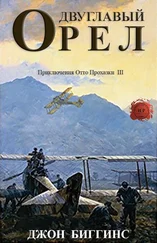“Ready to start?”
“Ready to start, Herr Leutnant. Electrical contacts closed?”
I glanced at the switch panel. “Electrical contacts closed: suck in.”
Prokesch turned the propeller to suck air-and-petrol mixture into the cylinders.
“Sucked in, Herr Leutnant. Open contacts now if you please.” I indicated the ignition switch to Toth, who flicked it down.
“Electrical contacts open. Start the engine.” With that, Toth began cranking the little starter magneto—“the coffee grinder”—on the cockpit bulkhead while Prokesch took a swing at the propeller. It fired first time, the engine roaring into life as gouts of smoke and blue-green flame rippled from the six stub-exhausts. I let it warm up for a minute or so, looked to make sure that Schraffl’s engine was also running, then waved to the ground crew. The mechanics pulled the chocks from in front of the wheels, threw them aside, then ducked underneath the aeroplane to sprawl themselves forward over the lower wings, one man lying on each side just inboard of the struts. The reason for this was that, with the engine and radiator completely blocking the pilot’s view forward, Brandenburgers were notoriously tricky to taxi on the ground and were always piling up against posts or running into other aircraft. The mechanics were there to give directions to Toth as he opened the throttle and the aeroplane started to lurch across the stony grass field.
We turned into the wind—a faint westerly breeze this early in the morning—and Toth gave full throttle as the two mechanics waved to signal “All clear ahead” and slid back off the wings. The air began to sing past us as the Brandenburger gathered speed, wheels bouncing on the bumpy field. Take-off runs were minimal in those days when aeroplanes started to lift off at near-bicycle speeds: 150 metres or less if the aeroplane was lightly laden. Soon a faint lurch and sudden smoothing of the motion signalled that we had left the ground behind. Toth lugged back the control column—not a modern joystick but a backward-and-forward post with a small wooden motor-car steering wheel on top—and soon we were climbing away from Fliegerfeld Caprovizza, banking to port to make the regulation two circuits of the airfield: a precaution against engine failure, since the probability was that if a piston was going to seize, it would do so now rather than later on. Meanwhile Schraffl and Jahudka had climbed into the air astern of us. Once I saw that they had made their circuits too I fired a green flare to signal that all was well, and we set off down the Vippaco Valley, heading for the town of Gorz and the enemy lines in the hills to west of it. We were on our way. Whether we would make the same journey in the opposite direction would become clear during the next ninety minutes or so.
We climbed gently as we flew down the broad, uneven valley of the Vippaco, heading for the point where that river joins the Isonzo just south of Gorz. Our aim was to cross the lines at about three thousand metres, then head north-east towards Udine for a while to confuse the Italian observers on the ground, who would telephone our height and direction as soon as they saw us pass overhead. We would then turn south-westwards and circle round to approach Palmanova from the direction of Venice, hoping in this way that we would be taken for Italian aircraft and left alone by any anti-aircraft batteries around our target. I checked my map and ticked off the towns and villages of the Vippaco Valley as we flew over them: Santa Croce and Dornberg and Prvacina and Ranziano; not so much for navigational purposes—we were following the railway line and river anyway—as to memorise their appearance for future flights when visibility might be poor and there might be no time to consult the map. How considerate it had been of previous generations (I thought) to have built so many hill-top monasteries around Gorz—Monte Vecchio and San Gabriele and Monte Santo. As a sceptic I doubted their religious efficacy; but there was no denying that as air-navigation beacons they took some beating, stuck up there on their mountain-peaks and painted white and yellow to stand out against the dark green pine forests. Meanwhile, away to westward, the guns flashed from time to time among the wooded hills across the Isonzo.
The sun was well up as we passed over the town of Gorz: still largely undamaged despite the closeness of the lines. The castle and the twin- domed cathedral were clearly visible in the early-morning light, and the silvery ribbon of the Isonzo branching and rejoining among the summer- dry banks of pebbles as it made its way towards the sea. Then we crossed the trench lines, which here climbed up from the valley floor to wind among the devastated forests of Podgora and Monte Sabotino on the west bank of the Isonzo. It was around here if anywhere that we would meet flak artillery fire. I peered ahead apprehensively—then saw three quick red flashes and puffs of dirty black smoke in the sky far ahead of us. A feeling of intense relief surged through me. Utterly feeble: so typical of the Italians and their charming incompetence. If that was the best they could do then—It was like a sudden, heavy kick in the backside: three or four shells bursting below us with a concussion that knocked the air out of my lungs and tossed the aeroplane around much as a number of badminton players will bat a shuttlecock from one to the other. I clutched the cockpit edge in alarm as Toth looked down, snorted in disgust and began to weave the aeroplane from side to side to put the gunners off their aim. I looked up and saw that Schraffl—now well above us—was doing the same. Other shells followed, but none came as close as that early group, and within a minute or two we were well beyond the lines and out of reach. A few puffs of smoke hung in the sky astern as if to say “You are lucky this time, porci Austriaci, but there’s always another day . . .” Twenty minutes later we were approaching Palmanova from the west.
Because everything happens so much faster, and in three dimensions instead of two, air navigation has always been a rather hit-or-miss business compared with position-finding at sea. I imagine that this is still largely true even now; and in those far-off times seventy years ago it was true—how do you say?—with brass knobs on it. Even so, it would have required a complete imbecile not to have recognised the town of Palmanova, because I think that in the whole of Europe there can scarcely be another settlement so instantly recognisable from the air. I whistled in admiration as we flew over it, so lost in wonder that I almost forgot to check the time and line us up for our photographic run along the railway line. I suppose that in the years since, the growth of suburbs and factory estates must have blurred its outlines; but as I saw it that July morning it still possessed that pristine purity of form in which its builders had left it: a perfect Renaissance fortress-town laid out like a star of David with successive rings of earthworks—lunettes and ravelins and bastions— surrounding it in what could well have been an engraving from a Leonardo da Vinci treatise on the art of fortification. It was so perfect that I half expected to see a scrolled cartouche in the fields near by with a pair of dividers, a scale of yards and a copperplate legend: “Senatus Serenissimae Republicae Venetii castrum et oppidum Palmae Novae aedificavit anno domini 1580,” or something similar. It suddenly occurred to me that Toth and I were among the very few people who had ever had the privilege to see the place from above, exactly as its architects had designed it.
But we had more important things to do that morning than study sixteenth-century military engineering. More technologically advanced and far less aesthetically pleasing ways of killing people were our immediate concern as we lined up to run along the railway track leading towards Udine. Toth brought us down until the altimeter read exactly the three thousand metres prescribed by our orders. I pulled back the cuff of my flying overall and glanced at my wristwatch. Even in July over Italy the air was near-freezing this high up, and I felt the cold suddenly bite at my exposed skin. Right on time: the seconds hand was just sweeping up towards 0630. Really this was too easy. I glanced down and saw the dark oblong stacks of shells piled up neatly alongside the railway track for a good two or three kilometres. Then I bent down to slide open the hatch in the cockpit floor. As the hands of the watch touched 0630 I pulled the lever for the first exposure.
Читать дальше












